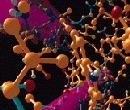Engineering can cut protein aggregation during storage
Aggregation of therapeutic proteins during storage shortens the shelf-life of products by limiting efficacy and boosting immunogenicity. Excipients and chemical modification counteract the process, and some believe further gains can be made by applying protein engineering techniques.
“The huge spectrum of possibilities of post-production-addressed protein engineering is probably yet to be realised”, said the authors, from Barcelona genetics and biotech institutes, in the journal Microbial Cell Factories.
Protein engineering, such as point mutation, is used to cut aggregation during production but, say the academics, can also perform a similar role after manufacturing is completed. For example, N-terminal peptide deletion can improve the stability of keratinocyte growth factor (KGF).
Other, non-protein engineering techniques for stabilisation and extension of half-lives include: protein adsorption onto nanoparticles; nano and micro encapsulation; or embedding in biocompatible materials.
Performance enhancing
Protein modification can also impact performance in vivo. Previous research suggests protein engineering can confer: tissue targeting; improved cell penetration; longer half-life; and the ability to cross the blood-brain barrier (BBB).
“Further exploration of protein engineering focused on post-production issues is strongly required and it should allow the emergence of optimised drugs to fulfil their increasing demand”, the authors said.
Performance enhancing protein modifications previously developed by researchers include: improved insulin bioavailability through amino acid substitution; greater stability following fusion of a HIV Tat segment; and a longer half-life after incorporation of albumin.
Development of artificial viruses is another application. “Creating multifunctional proteins by the appropriate combination of protein domains in a single polypeptide chain is being especially explored for the construction of protein-only artificial viruses”, the authors said.







